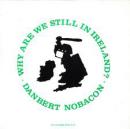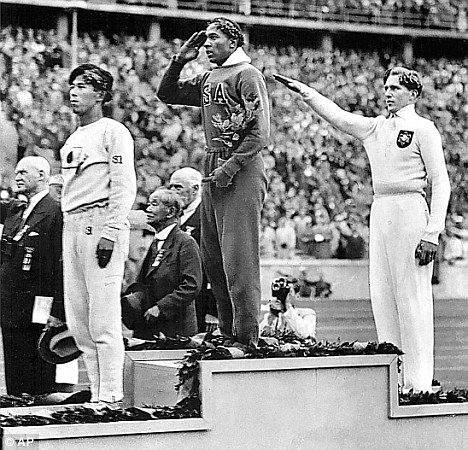In '36 the world's teams
Played up, played up, and played the game
Runners, jumpers, footballers
All sieg-heilling the Fuhrer
Not so the black Americans
Who, point-blank, refused
And on returning home from this precedent
Were refused a meeting with the president
Played up, played up, and played the game
Runners, jumpers, footballers
All sieg-heilling the Fuhrer
Not so the black Americans
Who, point-blank, refused
And on returning home from this precedent
Were refused a meeting with the president
Contributed by DonQUijote82 - 2012/3/19 - 19:53
Ho inserito questo testo 7 anni fa, trovandolo attribuito ai Chumbawamba, in realtà è uscito nell'album citato da B.B. a nome Sportchestra! Una sorta di supergruppo di cui facevano parte i Chumbawamba, ma anche molti ospiti (discogs).
Qui si può ascoltare il disco intero, in cui sono raccolte molte altre CCG da inserire
Qui si può ascoltare il disco intero, in cui sono raccolte molte altre CCG da inserire
Dq82 - 2019/6/13 - 12:30
Language: Finnish
Traduzione finlandese / Finnish translation / Traduction finnoise / Suomennos: Juha Rämö
Berliinin olympialaiset oli määrä pitää vuonna 1916, mutta ensimmäinen maailmasota siirsi ne aina vuoteen 1936, jolloin kansallissosialistit olivat olleet vallassa runsaat kolme vuotta. Hitler halusi saada kisoista mahdollisimman suuren propagandahyödyn. Tätä varten tarvittiin uusi uljas olympiapuisto ja sinne mahtipontinen stadion, jossa oli tilaa peräti 100 000 katsojalle. Stadionin tieltä purettiin vuoden 1916 peruuntuneita kisoja varten rakennettu Deutsches Stadion. Rakentaminen, joka työllisti enimmillään 2 600 ihmistä, aloitettiin vuonna 1934 ja saatiin päätökseen kaksi vuotta myöhemmin. Rakennustöihin saivat osallistua vain Saksan kansalaiset, jotka olivat arjalaista syntyperää.
Sodan aikana saksalainen yritys Blaupunkt valmisti stadionin tiloissa räjähteissä käytettyjä sytyttimiä ja rakennuksen maanalaisia tiloja käytettiin ilmasuojana. Sodan jälkeen stadion on kokenut kaksi suurta muodonmuutosta: katsomot saivat katteen vuoden 1974 jalkapallon MM-kisoihin, ja 2000-luvun alussa stadion peruskorjattiin vuoden 2006 jalkapallon MM-kisoja ja kolme vuotta myöhemmin järjestettyjä yleisurheilun MM-kisoja varten.
The 1916 Summer Olympics were scheduled to be held in Berlin but cancelled due to World War I. By the time of the 1936 Berlin Olympics, the Nazis had been in power for three years. Hitler saw the games as an opportunity to promote Nazi ideals and supremacy. For that purpose, a spectacular Olympic Park housing a new 100 000-seat track and field stadium replacing the German Stadium built for the 1916 Games, was laid down. At the peak of the construction work that took place from 1934 to 1936, 2 600 born Germans with Aryan ancestry were working on the building site.
During World War II, the underground spaces of the Stadium were used as air-raid shelters and for manufacturing detonators for explosives. After the war, the Stadium has undergone two major upgrades. The grandstand was roofed for the 1974 Football World Cup and the entire arena thorougly renovated in the early 2000s for the 2006 Football World Cup and the 2009 World Champioships in Athletics.
Muinaisten germaanien käräjäpaikkaperinteen innoittama jättimäinen ulkoilmanäyttämö Waldbühne valmistui olympiapuistoon 1936. Sen alkuperäinen nimi oli Dietrich-Eckart-Freilichtbühne, millä Hitler halusi kunnioittaa edesmennyttä ystäväänsä ja neuvonantajaansa natsien pää-äänenkannattajan Völkischer Beobachterin ensimmäistä päätoimittajaa Dietrich Eckartia.
Hitlerin vaatimuksesta amfiteatteriin piti alun perin mahtua 100 000 katsojaa, mutta lopulta paikkoja rakennettiin »vain« 22 000. Olympialaisten aikana näyttämö toimi voimisteluareenana, minkä lisäksi siellä esitettiin kisojen oheisohjelmaa, kuten Händelin ooppera Herakles.
Sodan jälkeen Walbühne toimi mm. Berliinin elokuvajuhlien näyttämönä. Nykyisin siellä järjestetään pääasiassa rock-, pop- ja klassisen musiikin konsertteja. Jo perinteeksi on muodostunut Berliinin filharmonikkojen ohjelmakauden päättäjäiskonsertti Waldbühnen lavalla.
Another mega structure of the Berlin Olympics, the Waldbühne, originally named Dietrich Eckart Open Air Theatre after Dietrich Eckart, Hitler's friend and mentor and original publisher of the Nazi party organ Völkischer Beobachter, was built in the Olympic Park as an amphitheatre inspired by the ancient Germanic Thing (Thingspiele) tradition.
On Hitler's demand, the stage was originally meant to seat 100 000 people, but at the end, »only« 22 000 seats were built. During the games, the stage was used as an arena for gymnastics and side events such as the performance of »Hercules« by G. F. Händel.
After the war, the stage has been used as a venue of the Berlin International Film Festival and rock concerts by mega stars such as The Rolling Stones, Jimi Hendrix, Metallica, Queen and U2. One of the modern traditions of the Walbühne is the annual roundup concert of the Berlin Philharmonic Orchestra.
Berliinin olympialaiset oli määrä pitää vuonna 1916, mutta ensimmäinen maailmasota siirsi ne aina vuoteen 1936, jolloin kansallissosialistit olivat olleet vallassa runsaat kolme vuotta. Hitler halusi saada kisoista mahdollisimman suuren propagandahyödyn. Tätä varten tarvittiin uusi uljas olympiapuisto ja sinne mahtipontinen stadion, jossa oli tilaa peräti 100 000 katsojalle. Stadionin tieltä purettiin vuoden 1916 peruuntuneita kisoja varten rakennettu Deutsches Stadion. Rakentaminen, joka työllisti enimmillään 2 600 ihmistä, aloitettiin vuonna 1934 ja saatiin päätökseen kaksi vuotta myöhemmin. Rakennustöihin saivat osallistua vain Saksan kansalaiset, jotka olivat arjalaista syntyperää.
Sodan aikana saksalainen yritys Blaupunkt valmisti stadionin tiloissa räjähteissä käytettyjä sytyttimiä ja rakennuksen maanalaisia tiloja käytettiin ilmasuojana. Sodan jälkeen stadion on kokenut kaksi suurta muodonmuutosta: katsomot saivat katteen vuoden 1974 jalkapallon MM-kisoihin, ja 2000-luvun alussa stadion peruskorjattiin vuoden 2006 jalkapallon MM-kisoja ja kolme vuotta myöhemmin järjestettyjä yleisurheilun MM-kisoja varten.
The 1916 Summer Olympics were scheduled to be held in Berlin but cancelled due to World War I. By the time of the 1936 Berlin Olympics, the Nazis had been in power for three years. Hitler saw the games as an opportunity to promote Nazi ideals and supremacy. For that purpose, a spectacular Olympic Park housing a new 100 000-seat track and field stadium replacing the German Stadium built for the 1916 Games, was laid down. At the peak of the construction work that took place from 1934 to 1936, 2 600 born Germans with Aryan ancestry were working on the building site.
During World War II, the underground spaces of the Stadium were used as air-raid shelters and for manufacturing detonators for explosives. After the war, the Stadium has undergone two major upgrades. The grandstand was roofed for the 1974 Football World Cup and the entire arena thorougly renovated in the early 2000s for the 2006 Football World Cup and the 2009 World Champioships in Athletics.
Muinaisten germaanien käräjäpaikkaperinteen innoittama jättimäinen ulkoilmanäyttämö Waldbühne valmistui olympiapuistoon 1936. Sen alkuperäinen nimi oli Dietrich-Eckart-Freilichtbühne, millä Hitler halusi kunnioittaa edesmennyttä ystäväänsä ja neuvonantajaansa natsien pää-äänenkannattajan Völkischer Beobachterin ensimmäistä päätoimittajaa Dietrich Eckartia.
Hitlerin vaatimuksesta amfiteatteriin piti alun perin mahtua 100 000 katsojaa, mutta lopulta paikkoja rakennettiin »vain« 22 000. Olympialaisten aikana näyttämö toimi voimisteluareenana, minkä lisäksi siellä esitettiin kisojen oheisohjelmaa, kuten Händelin ooppera Herakles.
Sodan jälkeen Walbühne toimi mm. Berliinin elokuvajuhlien näyttämönä. Nykyisin siellä järjestetään pääasiassa rock-, pop- ja klassisen musiikin konsertteja. Jo perinteeksi on muodostunut Berliinin filharmonikkojen ohjelmakauden päättäjäiskonsertti Waldbühnen lavalla.
Another mega structure of the Berlin Olympics, the Waldbühne, originally named Dietrich Eckart Open Air Theatre after Dietrich Eckart, Hitler's friend and mentor and original publisher of the Nazi party organ Völkischer Beobachter, was built in the Olympic Park as an amphitheatre inspired by the ancient Germanic Thing (Thingspiele) tradition.
On Hitler's demand, the stage was originally meant to seat 100 000 people, but at the end, »only« 22 000 seats were built. During the games, the stage was used as an arena for gymnastics and side events such as the performance of »Hercules« by G. F. Händel.
After the war, the stage has been used as a venue of the Berlin International Film Festival and rock concerts by mega stars such as The Rolling Stones, Jimi Hendrix, Metallica, Queen and U2. One of the modern traditions of the Walbühne is the annual roundup concert of the Berlin Philharmonic Orchestra.
AMERIKKA
Vuonna 36 maailman urheilijat
panivat parastaan kaikkien aikojen kisoissa,
juoksijat, hyppääjät, jalkapalloilijat,
kaikki Hitlerille hurraten,
kaikki paitsi mustat amerikkalaiset,
jotka kieltäytyivät jyrkästi
ja jotka palattuaan kotiin tämän ennakkotapauksen jälkeen
eivät saaneet kutsua presidentin vastaanotolle.
Vuonna 36 maailman urheilijat
panivat parastaan kaikkien aikojen kisoissa,
juoksijat, hyppääjät, jalkapalloilijat,
kaikki Hitlerille hurraten,
kaikki paitsi mustat amerikkalaiset,
jotka kieltäytyivät jyrkästi
ja jotka palattuaan kotiin tämän ennakkotapauksen jälkeen
eivät saaneet kutsua presidentin vastaanotolle.
Contributed by Juha Rämö - 2019/6/19 - 15:38
×
![]()
Note for non-Italian users: Sorry, though the interface of this website is translated into English, most commentaries and biographies are in Italian and/or in other languages like French, German, Spanish, Russian etc.











Non trovo questo brano in nessun album dei Chumbawamba, solo in una compilation di autori vari del 1988 intitolata "Sportchestra! – 101 Songs About Sport".
Sulle Olimpiadi del 36 nella Berlino nazista, dove Jesse Owens trionfò, ma al suo ritorno in patria trovò il razzismo di sempre, incarnato addirittura in Roosevelt il quale, essendo in campagna elettorale, non volle incontrarlo per non inimicarsi l'elettorato WASP.
(B.B.)